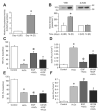Contrasting effects of ERK on tight junction integrity in differentiated and under-differentiated Caco-2 cell monolayers
- PMID: 20961289
- PMCID: PMC4438673
- DOI: 10.1042/BJ20100249
Contrasting effects of ERK on tight junction integrity in differentiated and under-differentiated Caco-2 cell monolayers
Abstract
ERK (extracellular-signal-regulated kinase) activation leads to disruption of tight junctions in some epithelial monolayers, whereas it prevents disruption of tight junctions in other epithelia. The factors responsible for such contrasting influences of ERK on tight junction integrity are unknown. The present study investigated the effect of the state of cell differentiation on ERK-mediated regulation of tight junctions in Caco-2 cell monolayers. EGF (epidermal growth factor) potentiated H2O2-induced tight junction disruption in under-differentiated cell monolayers, which was attenuated by the MEK [MAPK (mitogen-activated protein kinase)/ERK kinase] inhibitor U0126. In contrast, EGF prevented H2O2-induced disruption of tight junctions in differentiated cell monolayers, which was also attenuated by U0126. Knockdown of ERK1/2 enhanced tight junction integrity and accelerated assembly of tight junctions in under-differentiated cell monolayers, whereas it had the opposite effect in differentiated cell monolayers. Regulated expression of wild-type and constitutively active MEK1 disrupted tight junctions, and the expression of dominant-negative MEK1 enhanced tight junction integrity in under-differentiated cells, whereas contrasting responses were recorded in differentiated cells. EGF prevented both H2O2-induced association of PP2A (protein phosphatase 2A), and loss of association of PKCζ (protein kinase Cζ), with occludin by an ERK-dependent mechanism in differentiated cell monolayers, but not in under-differentiated cell monolayers. Active ERK was distributed in the intracellular compartment in under-differentiated cell monolayers, whereas it was localized mainly in the perijunctional region in differentiated cell monolayers. Thus ERK may exhibit its contrasting influences on tight junction integrity in under-differentiated and differentiated epithelial cells by virtue of differences in its subcellular distribution and ability to regulate the association of PKCζ and PP2A with tight junction proteins.
Figures








Similar articles
-
ERK is involved in EGF-mediated protection of tight junctions, but not adherens junctions, in acetaldehyde-treated Caco-2 cell monolayers.Am J Physiol Gastrointest Liver Physiol. 2011 Jul;301(1):G50-9. doi: 10.1152/ajpgi.00494.2010. Epub 2011 Apr 7. Am J Physiol Gastrointest Liver Physiol. 2011. PMID: 21474650 Free PMC article.
-
MAPK interacts with occludin and mediates EGF-induced prevention of tight junction disruption by hydrogen peroxide.Biochem J. 2006 Jan 1;393(Pt 1):69-77. doi: 10.1042/BJ20050959. Biochem J. 2006. PMID: 16134968 Free PMC article.
-
Protein phosphatase 2A plays a role in hydrogen peroxide-induced disruption of tight junctions in Caco-2 cell monolayers.Biochem J. 2009 Jun 12;421(1):59-70. doi: 10.1042/BJ20081951. Biochem J. 2009. PMID: 19356149 Free PMC article.
-
Molecular physiology and pathophysiology of tight junctions III. Tight junction regulation by intracellular messengers: differences in response within and between epithelia.Am J Physiol Gastrointest Liver Physiol. 2000 Oct;279(4):G660-5. doi: 10.1152/ajpgi.2000.279.4.G660. Am J Physiol Gastrointest Liver Physiol. 2000. PMID: 11005751 Review.
-
Mammalian tight junctions in the regulation of epithelial differentiation and proliferation.Curr Opin Cell Biol. 2005 Oct;17(5):453-8. doi: 10.1016/j.ceb.2005.08.003. Curr Opin Cell Biol. 2005. PMID: 16098725 Review.
Cited by
-
Chitosan Oligosaccharide Prevents Afatinib-Induced Barrier Disruption and Chloride Secretion through Modulation of AMPK, PI3K/AKT, and ERK Signaling in T84 Cells.Polymers (Basel). 2022 Oct 11;14(20):4255. doi: 10.3390/polym14204255. Polymers (Basel). 2022. PMID: 36297833 Free PMC article.
-
Early Activation of MAPK p44/42 Is Partially Involved in DON-Induced Disruption of the Intestinal Barrier Function and Tight Junction Network.Toxins (Basel). 2016 Sep 8;8(9):264. doi: 10.3390/toxins8090264. Toxins (Basel). 2016. PMID: 27618100 Free PMC article.
-
Epithelial barriers in allergy and asthma.J Allergy Clin Immunol. 2020 Jun;145(6):1499-1509. doi: 10.1016/j.jaci.2020.04.010. J Allergy Clin Immunol. 2020. PMID: 32507228 Free PMC article. Review.
-
Co- and Post-Treatment with Lysine Protects Primary Fish Enterocytes against Cu-Induced Oxidative Damage.PLoS One. 2016 Jan 26;11(1):e0147408. doi: 10.1371/journal.pone.0147408. eCollection 2016. PLoS One. 2016. PMID: 26812682 Free PMC article.
-
EphrinA1/EphA2 Promotes Epithelial Hyperpermeability Involving in Lipopolysaccharide-induced Intestinal Barrier Dysfunction.J Neurogastroenterol Motil. 2020 Jul 30;26(3):397-409. doi: 10.5056/jnm19095. J Neurogastroenterol Motil. 2020. PMID: 32606260 Free PMC article.
References
-
- Clayburgh DR, Shen L, Turner JR. A porous defense: the leaky epithelial barrier in intestinal disease. Lab. Invest. 2004;84:282–291. - PubMed
-
- Sawada N, Murata M, Kikuchi K, Osanai M, Tobioka H, Kojima T, Chiba H. Tight junctions and human diseases. Med. Electron. Microsc. 2003;36:147–156. - PubMed
-
- Saeki R, Kondoh M, Kakutani H, Tsunoda S, Mochizuki Y, Hamakubo T, Tsutsumi Y, Horiguchi Y, Yagi K. A novel tumor-targeted therapy using a claudin-4-targeting molecule. Mol. Pharmacol. 2009;76:918–926. - PubMed
-
- Martin TA, Jiang WG. Loss of tight junction barrier function and its role in cancer metastasis. Biochim. Biophys. Acta. 2009;1788:872–891. - PubMed
-
- Balda MS, Matter K. Tight junctions at a glance. J. Cell Sci. 2008;121:3677–3682. - PubMed
Publication types
MeSH terms
Substances
Grants and funding
LinkOut - more resources
Full Text Sources
Miscellaneous

